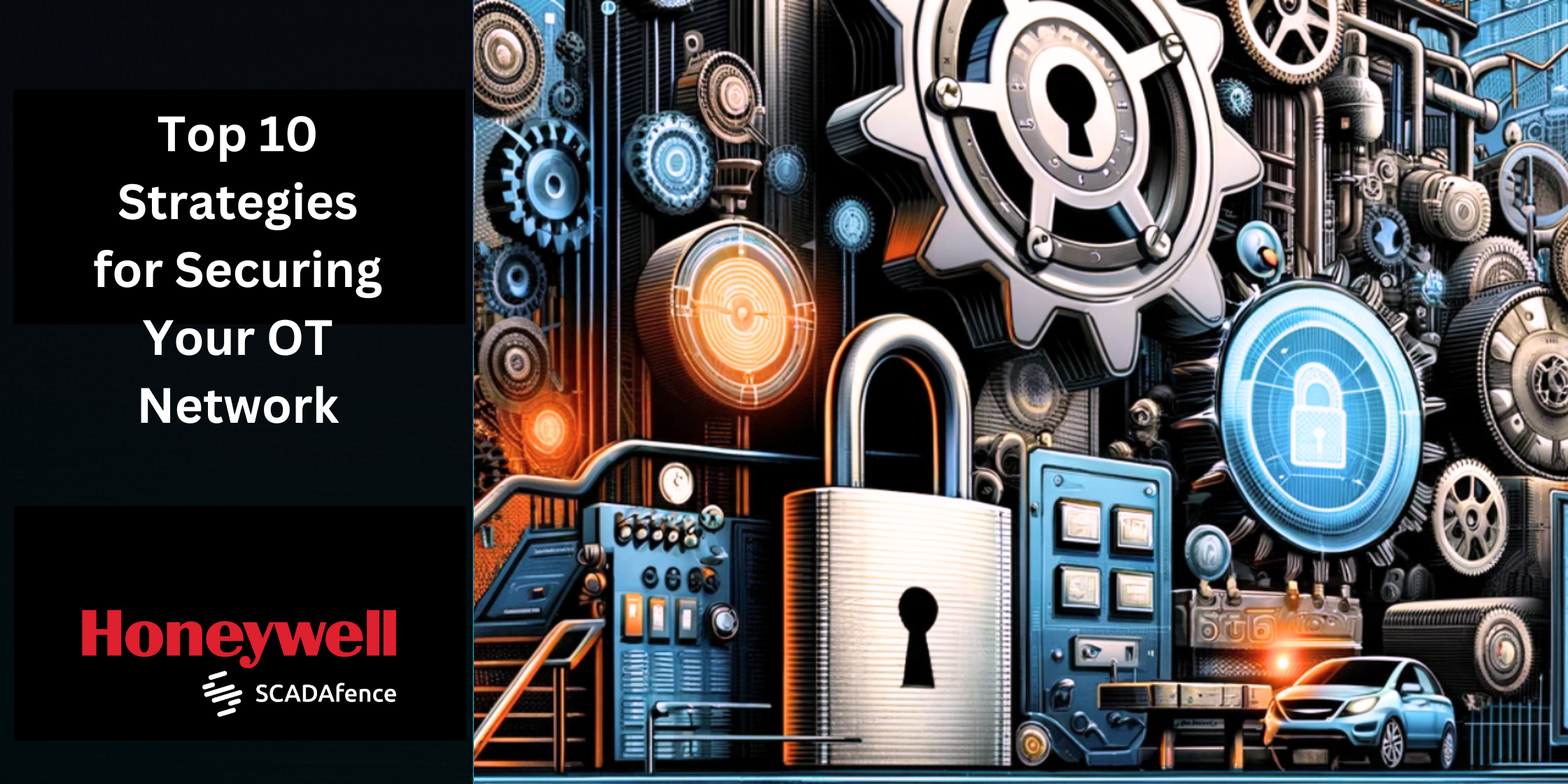Anyone involved in operational technology (OT) security already knows that the stakes are high.
Organizations that use OT are among the most frequently targeted by threat actors, with an eye-watering statistic of over 90% of organizations being hit by some form of cyberattack between 2020 and 2021. Meanwhile, data breaches remain a costly affair, with the average breach costing financial damage of US$4.45 million in 2023, marking a 15% increase over three years.
Fortunately, there is a silver lining, as organizations that use OT, and also invest in security and adopt best practices, stand to reduce the rate and severity of cyberattacks, avoiding data loss, downtime, and reputational damage.
So, to help you become a leader in OT security, we've compiled a list of 10 best practices for securing your OT network.
By implementing these strategies, you’ll create a robust, multilayered security strategy that keeps your critical assets safe for both the short and long term.
1. Network Segmentation and Isolation
Since OT systems are interconnected, one of the most effective ways to limit the potential impact of a cyber threat is to divide your network into smaller, more manageable segments. This practice, known as network segmentation, makes it harder for threats to propagate across your entire system.
Start by grouping assets based on their criticality and function, then use firewalls, virtual LANs (VLANs), and other network controls to create distinct security zones and control traffic flow between them.
Coupled with strict and targeted isolation of your OT network from your IT network and the internet (air gapping), segmentation creates a stronger barrier against cyberattacks.
2. Access Control and Management
Access control is critical for OT networks that combine on-premise and cloud-based software.
Breaches relating to access control are costly and long-winded to resolve. In fact, IBM found that compromised network access can take up to one year to resolve, resulting in significant downtime for OT networks. Consistent and robust access control measures protect against unauthorized access and attacks:
- Firstly, adopt the principle of least privilege (PoLP) for effective access control in OT environments. This means ensuring that users have only the access rights necessary to perform their specific job functions – no more, no less.
- Role-based access control (RBAC) should also be implemented to assign permissions based on well-defined roles and responsibilities.
- Enforcing multi-factor authentication (MFA) for all users, especially those with administrative or high-level access, adds an extra layer of security. Remarkably, just 38% of large organizations use multi-factor authentication (MFA).
We should mention that MFA isn’t foolproof, as shown by Adversary-in-the-Middle (AitM) attacks detected by Microsoft. These attacks steal login credentials and session cookies, allowing attackers to infiltrate an authenticated session. Combine POLP, RBAC, and MFA for comprehensive access security.
Lastly, remember to regularly review and audit user access rights to ensure they remain appropriate. Roles change, and employees come and go – promptly adjust and revoke permissions accordingly.
3. Secure Remote Access
The rise of remote work throughout the COVID-19 pandemic showcased the vulnerability posed by remote access, with malware and ransomware increasing by 358% and 435%, respectively. IBM also found that data breaches involving remote access were among the most costly, both financially and in reputational damage.
To combat this, use secure, encrypted channels for all remote connections. Virtual private networks (VPNs) with strong encryption are a first line of defense for protecting data in transit and preventing unauthorized interception.
Additionally, ensure that remote access is tightly controlled and monitored, with robust authentication mechanisms like MFA in place.
Other advanced remote access strategies include:
-
A Zero-Trust architecture: Implement a Zero-Trust security model that requires authentication, authorization, and encryption for all remote connections.
-
A Software-Defined Perimeter (SDP): Deploy an SDP solution to create a dynamic, identity-based access control system that hides network resources until users and devices are authenticated and authorized.
-
Behavioral analytics and machine learning: Deploy advanced behavioral analytics and machine learning to continuously monitor remote access activities, detect anomalies, and identify threats in real-time.

4. Regular Patching and Vulnerability Management
Keeping your OT systems up to date with the latest security patches is key to overall network security. UK government research found that patch management is lacking in 66% of UK businesses, leaving them exposed to vulnerabilities.
Establish a comprehensive patch management program that includes a process for identifying, prioritizing, and applying critical updates as quickly as possible. Consider virtual patching or other compensating controls where traditional patching isn’t feasible.
Patching OT Networks Demands Specific Strategies
Patching OT systems can be complex due to the sensitive nature of industrial control systems. Work closely with your equipment vendors to coordinate updates and minimize disruption.
SCADAfence recommends a four-point plan for patching OT networks:
-
Detect and discover: Identify all assets within the OT environment to understand the scope of what needs protection.
-
Assess for vulnerabilities: Evaluate industrial devices and OT equipment for vulnerabilities, typically including security risks or issues due to software and device misconfigurations.
-
Analyze and prioritize: Determine which vulnerabilities pose the greatest risk and prioritize them for patching, considering the operational impact and security benefits.
-
Remediate: Address vulnerabilities by patching or fixing configurations, like updating a Programmable Logic Controller (PLC).
For more advice on patching industrial devices specifically, view our guide here.
5. Monitoring and Anomaly Detection
Continuous monitoring is key to detecting and responding to potential security incidents in real-time. Deploy specialized monitoring tools to observe network traffic and system activities and to alert you to deviations from normal, expected behavior.
Look for solutions that leverage machine learning and artificial intelligence (AI) to establish a baseline of normal activity and flag suspicious events or anomalies.
By catching potential threats early, you can quickly investigate and take action to mitigate risks.
The SCADAfence platform provides accurate alerts about cybersecurity threats on your network, including anomalous or unauthorized events.
6. Incident Response and Recovery Planning
No matter how strong your defenses are, you need a well-defined incident response and recovery plan tailored to your OT environment. Just 54% of businesses have a disaster recovery plan in case.
Your plan should outline clear roles, responsibilities, and procedures for detecting, containing, and recovering from a cybersecurity incident.
Appoint key team members who will be instrumental in reporting and communicating details of the cyberattack to internal and external stakeholders. Everyone – from the board to the C-suite, managers, and other employees – should understand their role in responding to breaches and attacks.
Analyze Incident Recovery Times
A key component of incident response planning is determining how long your business can function following a breach and how quickly you can fail over to backup systems.
Relevant metrics include Mean Time to Acknowledge (or MTTA, the realization that a breach/attack is taking or has taken place) and Mean Time to Restore (MTTR, the time it takes to restore from backup systems and instigate recovery).
Run models to determine your MTTA and MTTR, regularly update your recovery plans, and conduct drills to ensure your team is prepared to act when needed.
7. Secure Configuration Management
Ensuring that all devices and systems in your OT environment are securely configured is fundamental to building network-wide security.
Start by creating a comprehensive inventory of your hardware and software OT assets.
Work with your vendors to understand the recommended security configurations for each component. Many industrial control systems have insecure default settings that must be changed before deployment. Use industry-specific guidelines, like the IEC 62443 standards, to inform configuration decisions.
Then, implement a robust change management process for documenting and approving changes to device configuration or network settings. This helps prevent misconfiguration or unauthorized changes that could introduce other vulnerabilities.
The SCADAfence Governance Portal helps you track and comply with the cybersecurity frameworks relevant to your network and assets, including IEC 62443, NIST-CSF, NERC-CIP, ISO-27001, NIST-1800-23, NCSC-CAF, and the EU NIS Directive.
8. Physical Security Integration
Don't overlook physical security when protecting your OT assets. Unauthorized physical access to industrial control systems can provide attackers with an easier path to compromising your network and can create network vulnerabilities.
In addition to physical sabotage or surveillance, physical intrusions could see threat actors download or install malware directly onto systems.
Deploy access controls, video surveillance, and other monitoring systems to restrict and detect any suspicious physical access attempts. Regularly assess your facilities for vulnerabilities and train employees on their role in maintaining physical security.
Be vigilant about who has access to your business, particularly regarding temporary or third-party workers.
9. Vendor and Industry Collaboration
Don’t underestimate the importance of collaboration and staying informed about the latest in OT security.
Maintain close communication with your equipment and software vendors and actively participate in security meetings, networks, and summits – both online and in person.
To keep security strategies current, ensure your security tools address risks specified in the MITRE ATT&CK framework and align your defenses with industry best practices.
10. Specialized OT Security Solutions
Given the unique challenges of securing OT environments, investing in purpose-built security solutions is a must.
The SCADAfence Platform is specifically designed for the risks and rigors of OT environments. It offers a range of advanced capabilities tailored to industrial networks:
- Automated asset discovery and inventory management
- Continuous threat monitoring and real-time alerts
- Deep packet inspection for analyzing industrial protocols
- Seamless integration with your existing security infrastructure
- Customizable dashboards for a bird’s-eye view of critical risks and network health
By choosing a specialized solution like SCADAfence, you can exceed OT-specific security and compliance targets, simplify risk management, and gain comprehensive visibility into assets.
Wrapping Up
Securing your OT network is a continuous process that requires a comprehensive, proactive approach.
By implementing these 10 best practices and partnering with OT security leaders like SCADAfence, you can build a strong defense that keeps your critical assets safe and your operations running smoothly.
Remember that the key to effective OT security is not just deploying the right technologies – it’s also fostering a culture of security awareness and collaboration across your entire organization.
Ready to take your OT security to the next level? Request a free demo of SCADAfence today and see how our cutting-edge platform can help you protect your network.


